Organisational Behaviour: Culture, Communication, and Motivation in Burberry
VerifiedAdded on 2023/01/05
|12
|3653
|98
AI Summary
This report explores the concepts of organisational culture, communication theories, and motivational theories in the context of Burberry. It discusses the different models of organisational culture, theories of communication, and motivational theories. The report also includes a primary research conducted on Burberry's organisational culture and its implementation of these theories.
Contribute Materials
Your contribution can guide someone’s learning journey. Share your
documents today.
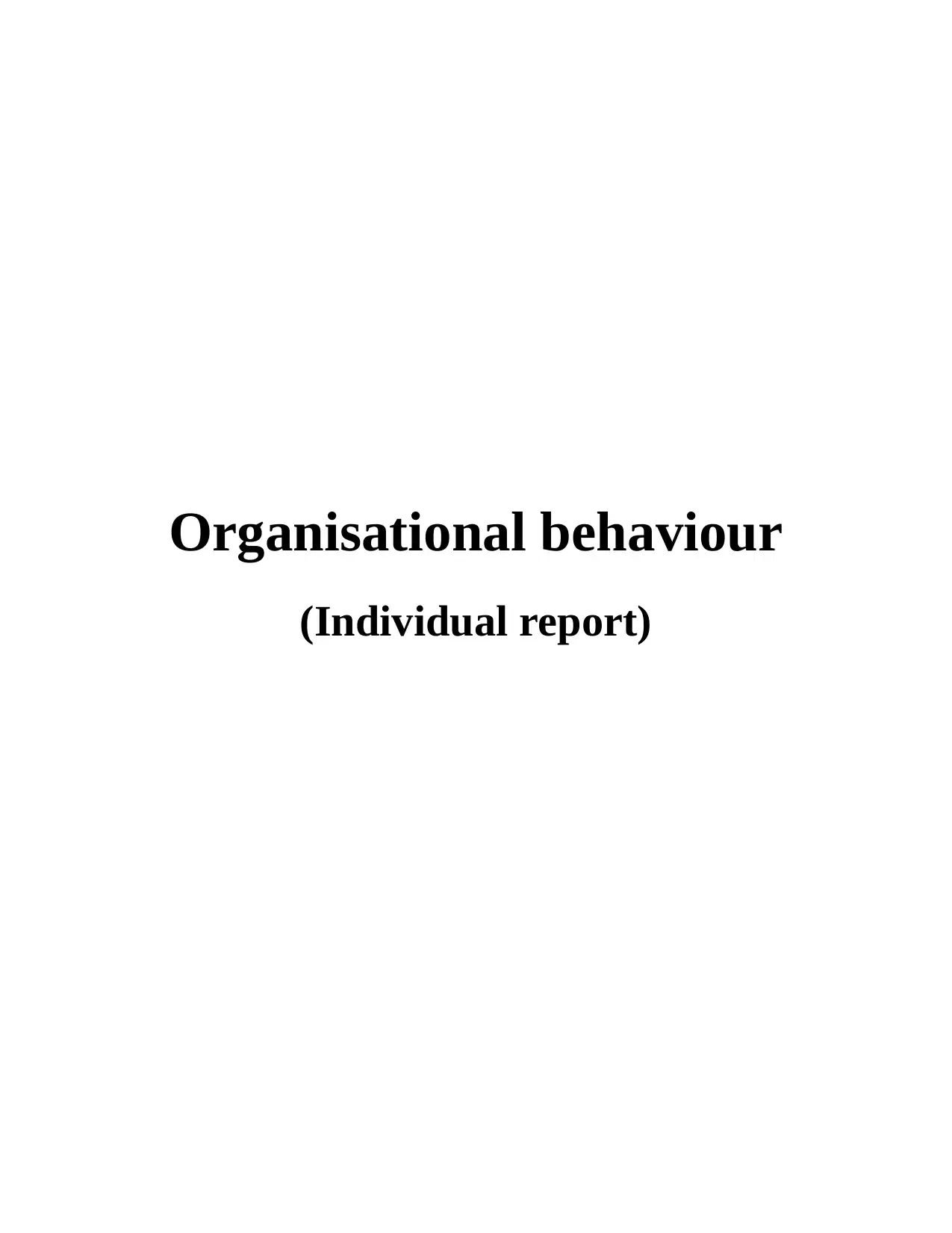
Organisational behaviour
(Individual report)
(Individual report)
Secure Best Marks with AI Grader
Need help grading? Try our AI Grader for instant feedback on your assignments.
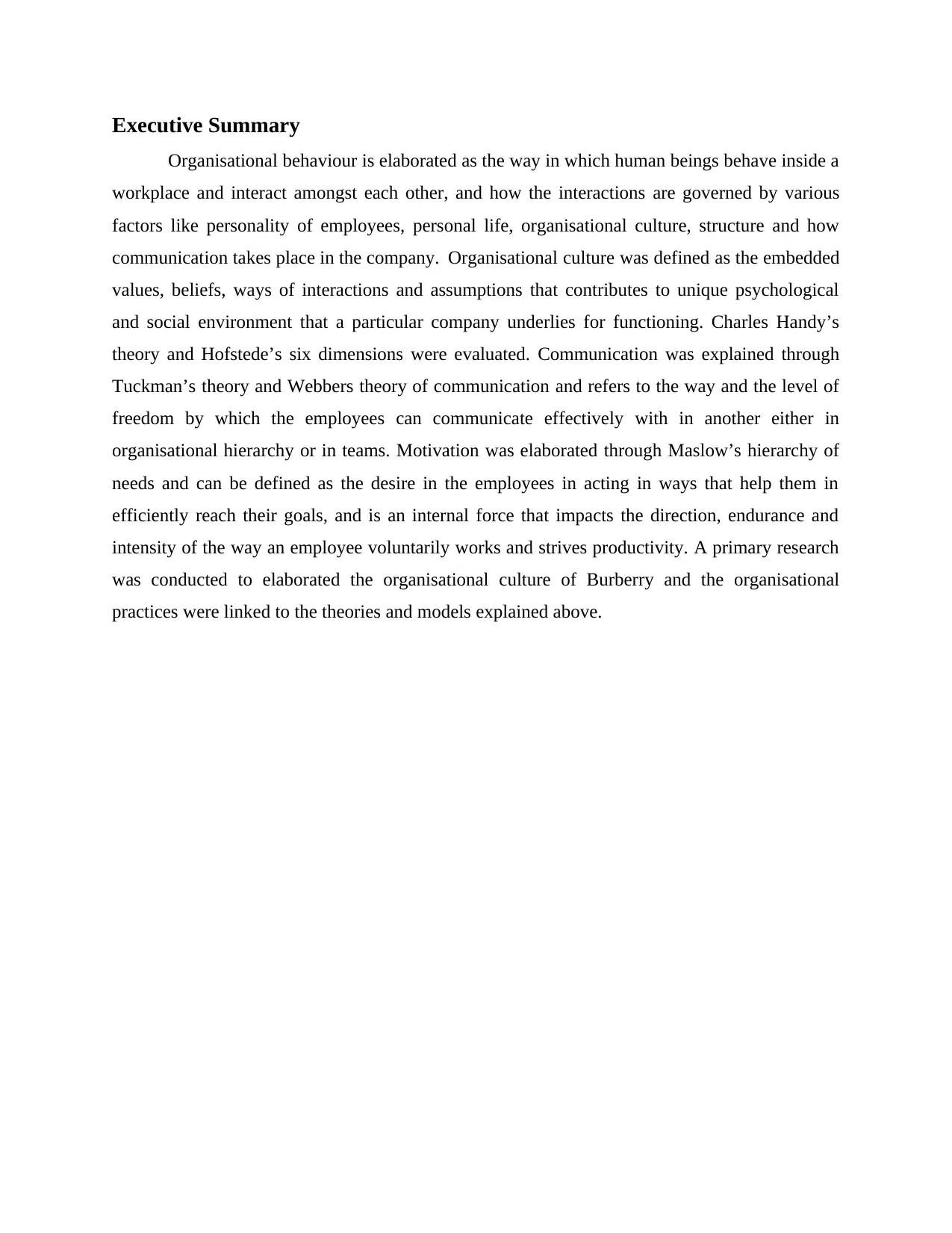
Executive Summary
Organisational behaviour is elaborated as the way in which human beings behave inside a
workplace and interact amongst each other, and how the interactions are governed by various
factors like personality of employees, personal life, organisational culture, structure and how
communication takes place in the company. Organisational culture was defined as the embedded
values, beliefs, ways of interactions and assumptions that contributes to unique psychological
and social environment that a particular company underlies for functioning. Charles Handy’s
theory and Hofstede’s six dimensions were evaluated. Communication was explained through
Tuckman’s theory and Webbers theory of communication and refers to the way and the level of
freedom by which the employees can communicate effectively with in another either in
organisational hierarchy or in teams. Motivation was elaborated through Maslow’s hierarchy of
needs and can be defined as the desire in the employees in acting in ways that help them in
efficiently reach their goals, and is an internal force that impacts the direction, endurance and
intensity of the way an employee voluntarily works and strives productivity. A primary research
was conducted to elaborated the organisational culture of Burberry and the organisational
practices were linked to the theories and models explained above.
Organisational behaviour is elaborated as the way in which human beings behave inside a
workplace and interact amongst each other, and how the interactions are governed by various
factors like personality of employees, personal life, organisational culture, structure and how
communication takes place in the company. Organisational culture was defined as the embedded
values, beliefs, ways of interactions and assumptions that contributes to unique psychological
and social environment that a particular company underlies for functioning. Charles Handy’s
theory and Hofstede’s six dimensions were evaluated. Communication was explained through
Tuckman’s theory and Webbers theory of communication and refers to the way and the level of
freedom by which the employees can communicate effectively with in another either in
organisational hierarchy or in teams. Motivation was elaborated through Maslow’s hierarchy of
needs and can be defined as the desire in the employees in acting in ways that help them in
efficiently reach their goals, and is an internal force that impacts the direction, endurance and
intensity of the way an employee voluntarily works and strives productivity. A primary research
was conducted to elaborated the organisational culture of Burberry and the organisational
practices were linked to the theories and models explained above.
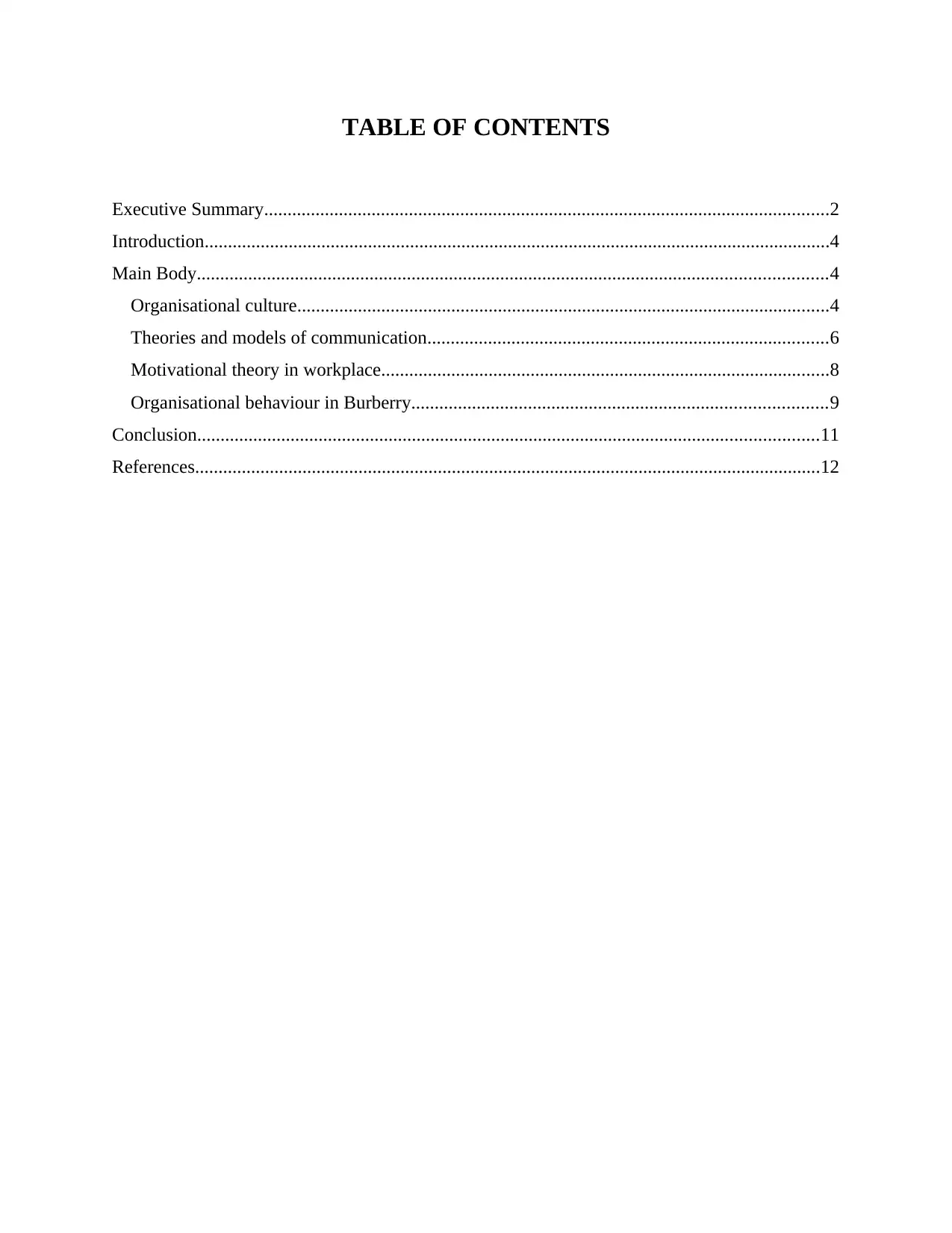
TABLE OF CONTENTS
Executive Summary.........................................................................................................................2
Introduction......................................................................................................................................4
Main Body.......................................................................................................................................4
Organisational culture..................................................................................................................4
Theories and models of communication......................................................................................6
Motivational theory in workplace................................................................................................8
Organisational behaviour in Burberry.........................................................................................9
Conclusion.....................................................................................................................................11
References......................................................................................................................................12
Executive Summary.........................................................................................................................2
Introduction......................................................................................................................................4
Main Body.......................................................................................................................................4
Organisational culture..................................................................................................................4
Theories and models of communication......................................................................................6
Motivational theory in workplace................................................................................................8
Organisational behaviour in Burberry.........................................................................................9
Conclusion.....................................................................................................................................11
References......................................................................................................................................12

Introduction
Organisational behaviour can be defined as the way in which human beings behave inside
a workplace and interact amongst each other, and how the interactions are governed by various
factors like personality of employees, personal life, organisational culture, structure and how
communication takes place in the company (Griffin and et.al., 2020). Organisational behaviour
includes the areas of teams, individuals, conflict management in employees, leadership and
management of employees, type of organisational structure adopted in the company and change
management. This report will focus upon secondary and primary research of Burberry which is a
UK based organisation. Burberry deals in luxury clothing and accessories for high end
consumers such as trench coats, leather goods, fashion accessories, cosmetics etc. This report
will highlight various models and theories in context to organisational culture, organisational
communication and team behaviour, various motivational theories and how Burberry implements
these in its workplace for managing employee and overall organisational behaviour.
Main Body
Organisational culture
Organisational culture can be referred to the embedded values, beliefs, ways of
interactions and assumptions that contributes to unique psychological and social environment
that a particular company underlies for functioning (Laforet, 2016). This involves the
experiences and expectations. Basically, certain philosophy that guides how the company will
operate.
Handy’s model of organisational culture
This model of organisational culture was developed by Charles handy who was a leading
authority of the subject area, and subsequently derived four various kinds of cultures that may
exist in any company, power, task, person and role cultures.
Power culture: This type of culture explains an environment were the leader ends to
make rapid decision and has a high control in the directing the organisation. There tends
to be few rules and regulations in the organisation and employees are evaluated on the
basis of their achievements. This is generally a string culture but can turn toxic very
swiftly (Handy, 2016).
4
Organisational behaviour can be defined as the way in which human beings behave inside
a workplace and interact amongst each other, and how the interactions are governed by various
factors like personality of employees, personal life, organisational culture, structure and how
communication takes place in the company (Griffin and et.al., 2020). Organisational behaviour
includes the areas of teams, individuals, conflict management in employees, leadership and
management of employees, type of organisational structure adopted in the company and change
management. This report will focus upon secondary and primary research of Burberry which is a
UK based organisation. Burberry deals in luxury clothing and accessories for high end
consumers such as trench coats, leather goods, fashion accessories, cosmetics etc. This report
will highlight various models and theories in context to organisational culture, organisational
communication and team behaviour, various motivational theories and how Burberry implements
these in its workplace for managing employee and overall organisational behaviour.
Main Body
Organisational culture
Organisational culture can be referred to the embedded values, beliefs, ways of
interactions and assumptions that contributes to unique psychological and social environment
that a particular company underlies for functioning (Laforet, 2016). This involves the
experiences and expectations. Basically, certain philosophy that guides how the company will
operate.
Handy’s model of organisational culture
This model of organisational culture was developed by Charles handy who was a leading
authority of the subject area, and subsequently derived four various kinds of cultures that may
exist in any company, power, task, person and role cultures.
Power culture: This type of culture explains an environment were the leader ends to
make rapid decision and has a high control in the directing the organisation. There tends
to be few rules and regulations in the organisation and employees are evaluated on the
basis of their achievements. This is generally a string culture but can turn toxic very
swiftly (Handy, 2016).
4
Secure Best Marks with AI Grader
Need help grading? Try our AI Grader for instant feedback on your assignments.
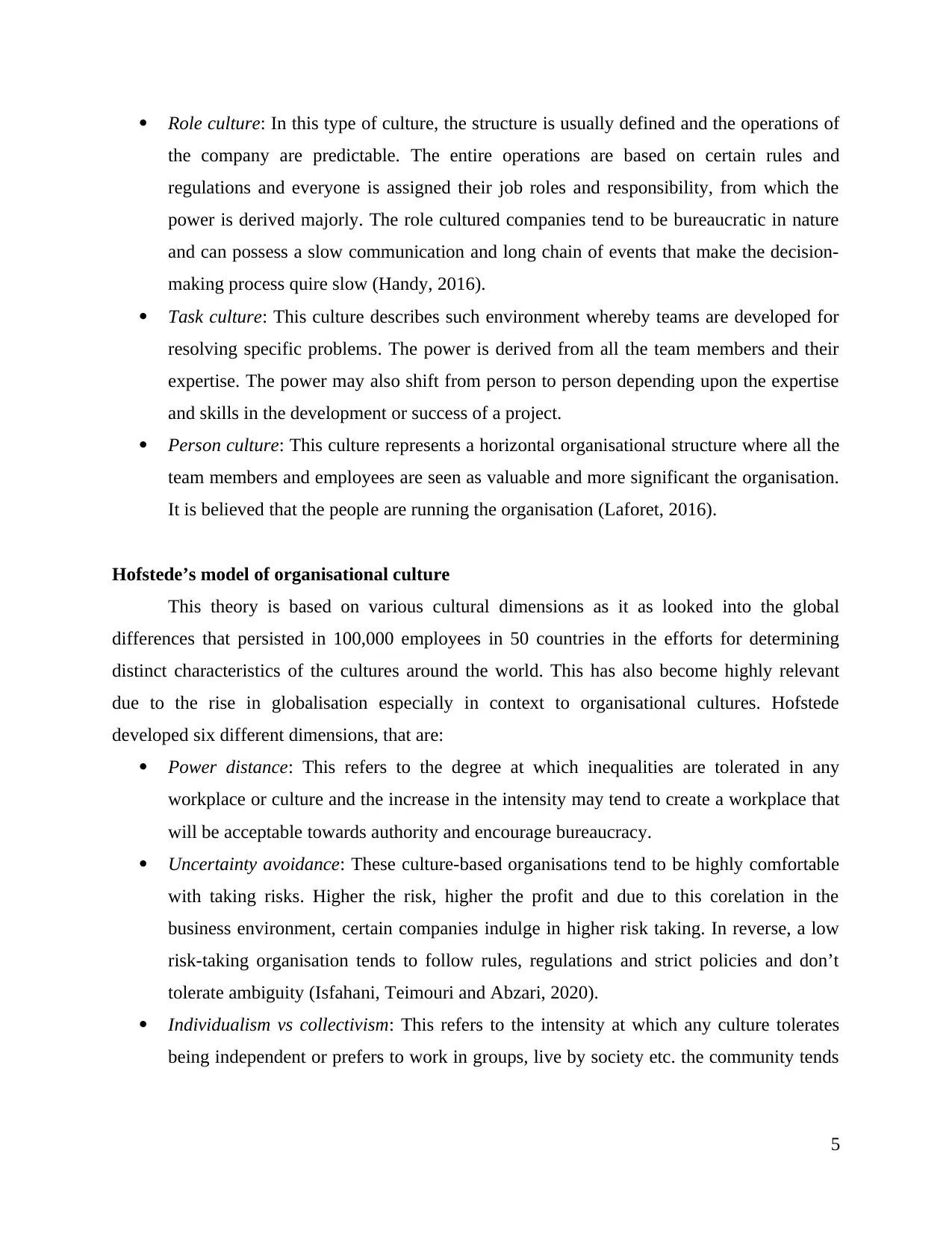
Role culture: In this type of culture, the structure is usually defined and the operations of
the company are predictable. The entire operations are based on certain rules and
regulations and everyone is assigned their job roles and responsibility, from which the
power is derived majorly. The role cultured companies tend to be bureaucratic in nature
and can possess a slow communication and long chain of events that make the decision-
making process quire slow (Handy, 2016).
Task culture: This culture describes such environment whereby teams are developed for
resolving specific problems. The power is derived from all the team members and their
expertise. The power may also shift from person to person depending upon the expertise
and skills in the development or success of a project.
Person culture: This culture represents a horizontal organisational structure where all the
team members and employees are seen as valuable and more significant the organisation.
It is believed that the people are running the organisation (Laforet, 2016).
Hofstede’s model of organisational culture
This theory is based on various cultural dimensions as it as looked into the global
differences that persisted in 100,000 employees in 50 countries in the efforts for determining
distinct characteristics of the cultures around the world. This has also become highly relevant
due to the rise in globalisation especially in context to organisational cultures. Hofstede
developed six different dimensions, that are:
Power distance: This refers to the degree at which inequalities are tolerated in any
workplace or culture and the increase in the intensity may tend to create a workplace that
will be acceptable towards authority and encourage bureaucracy.
Uncertainty avoidance: These culture-based organisations tend to be highly comfortable
with taking risks. Higher the risk, higher the profit and due to this corelation in the
business environment, certain companies indulge in higher risk taking. In reverse, a low
risk-taking organisation tends to follow rules, regulations and strict policies and don’t
tolerate ambiguity (Isfahani, Teimouri and Abzari, 2020).
Individualism vs collectivism: This refers to the intensity at which any culture tolerates
being independent or prefers to work in groups, live by society etc. the community tends
5
the company are predictable. The entire operations are based on certain rules and
regulations and everyone is assigned their job roles and responsibility, from which the
power is derived majorly. The role cultured companies tend to be bureaucratic in nature
and can possess a slow communication and long chain of events that make the decision-
making process quire slow (Handy, 2016).
Task culture: This culture describes such environment whereby teams are developed for
resolving specific problems. The power is derived from all the team members and their
expertise. The power may also shift from person to person depending upon the expertise
and skills in the development or success of a project.
Person culture: This culture represents a horizontal organisational structure where all the
team members and employees are seen as valuable and more significant the organisation.
It is believed that the people are running the organisation (Laforet, 2016).
Hofstede’s model of organisational culture
This theory is based on various cultural dimensions as it as looked into the global
differences that persisted in 100,000 employees in 50 countries in the efforts for determining
distinct characteristics of the cultures around the world. This has also become highly relevant
due to the rise in globalisation especially in context to organisational cultures. Hofstede
developed six different dimensions, that are:
Power distance: This refers to the degree at which inequalities are tolerated in any
workplace or culture and the increase in the intensity may tend to create a workplace that
will be acceptable towards authority and encourage bureaucracy.
Uncertainty avoidance: These culture-based organisations tend to be highly comfortable
with taking risks. Higher the risk, higher the profit and due to this corelation in the
business environment, certain companies indulge in higher risk taking. In reverse, a low
risk-taking organisation tends to follow rules, regulations and strict policies and don’t
tolerate ambiguity (Isfahani, Teimouri and Abzari, 2020).
Individualism vs collectivism: This refers to the intensity at which any culture tolerates
being independent or prefers to work in groups, live by society etc. the community tends
5
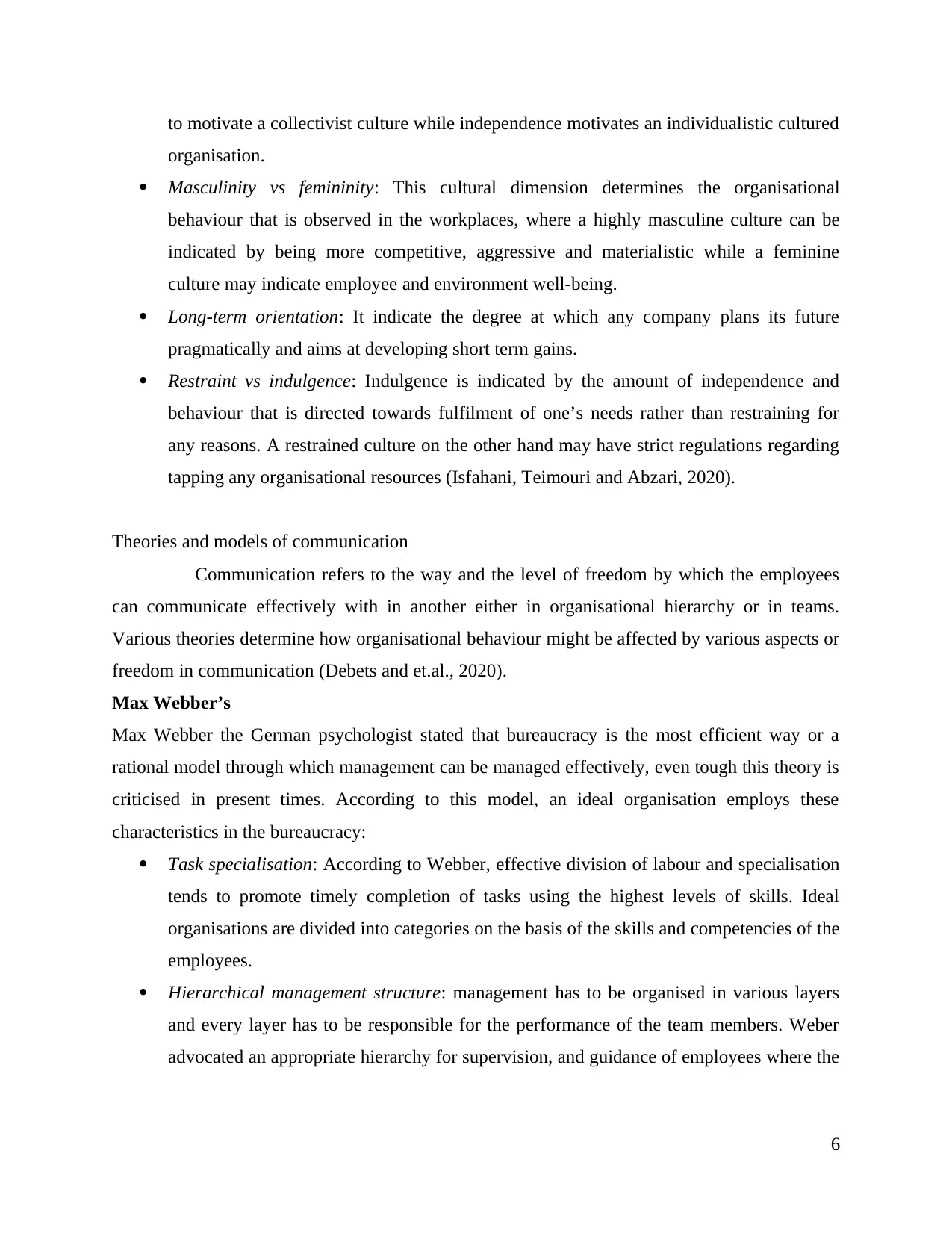
to motivate a collectivist culture while independence motivates an individualistic cultured
organisation.
Masculinity vs femininity: This cultural dimension determines the organisational
behaviour that is observed in the workplaces, where a highly masculine culture can be
indicated by being more competitive, aggressive and materialistic while a feminine
culture may indicate employee and environment well-being.
Long-term orientation: It indicate the degree at which any company plans its future
pragmatically and aims at developing short term gains.
Restraint vs indulgence: Indulgence is indicated by the amount of independence and
behaviour that is directed towards fulfilment of one’s needs rather than restraining for
any reasons. A restrained culture on the other hand may have strict regulations regarding
tapping any organisational resources (Isfahani, Teimouri and Abzari, 2020).
Theories and models of communication
Communication refers to the way and the level of freedom by which the employees
can communicate effectively with in another either in organisational hierarchy or in teams.
Various theories determine how organisational behaviour might be affected by various aspects or
freedom in communication (Debets and et.al., 2020).
Max Webber’s
Max Webber the German psychologist stated that bureaucracy is the most efficient way or a
rational model through which management can be managed effectively, even tough this theory is
criticised in present times. According to this model, an ideal organisation employs these
characteristics in the bureaucracy:
Task specialisation: According to Webber, effective division of labour and specialisation
tends to promote timely completion of tasks using the highest levels of skills. Ideal
organisations are divided into categories on the basis of the skills and competencies of the
employees.
Hierarchical management structure: management has to be organised in various layers
and every layer has to be responsible for the performance of the team members. Weber
advocated an appropriate hierarchy for supervision, and guidance of employees where the
6
organisation.
Masculinity vs femininity: This cultural dimension determines the organisational
behaviour that is observed in the workplaces, where a highly masculine culture can be
indicated by being more competitive, aggressive and materialistic while a feminine
culture may indicate employee and environment well-being.
Long-term orientation: It indicate the degree at which any company plans its future
pragmatically and aims at developing short term gains.
Restraint vs indulgence: Indulgence is indicated by the amount of independence and
behaviour that is directed towards fulfilment of one’s needs rather than restraining for
any reasons. A restrained culture on the other hand may have strict regulations regarding
tapping any organisational resources (Isfahani, Teimouri and Abzari, 2020).
Theories and models of communication
Communication refers to the way and the level of freedom by which the employees
can communicate effectively with in another either in organisational hierarchy or in teams.
Various theories determine how organisational behaviour might be affected by various aspects or
freedom in communication (Debets and et.al., 2020).
Max Webber’s
Max Webber the German psychologist stated that bureaucracy is the most efficient way or a
rational model through which management can be managed effectively, even tough this theory is
criticised in present times. According to this model, an ideal organisation employs these
characteristics in the bureaucracy:
Task specialisation: According to Webber, effective division of labour and specialisation
tends to promote timely completion of tasks using the highest levels of skills. Ideal
organisations are divided into categories on the basis of the skills and competencies of the
employees.
Hierarchical management structure: management has to be organised in various layers
and every layer has to be responsible for the performance of the team members. Weber
advocated an appropriate hierarchy for supervision, and guidance of employees where the
6

top management will have the highest power and the bottom level management will have
the least amount of power (Croucher and et.al., 2017).
Formal selection rules: According to Webber, an ideal organisation needed to possess
such selection criteria whereby the employees get selected through formal rules and the
skills they possess. The skills, knowledge and competencies of such employees should be
gained through formal educational systems, training or job experiences and nothing else.
Uniform and efficient requirements: Employees should be ware of the rules and
regulations and the expectations company has from them so that they perform efficiently.
There should be a uniformity in the company and senior management is responsible for
implementation of the regulations and policies to make the operations smooth and
business efficient (Debets and et.al., 2020).
Impersonal environment: Weber stated that the relationships between the employees
should be strictly professional. There should be no impersonal environment and the
decision have to be made only on rational thinking. According to Webber this helped in
the elimination of favouritism and nepotism and increased efficiency of formal
communication.
Achievement based organisation: As per Weber, no company should inculcate aspects
like personal favours, relationships or personality characteristics into the decision-making
regarding employees and communication. The company should promote employees on
the basis of their achievements, technical qualifications and experience (Croucher and
et.al., 2017).
Tuckman’s teamwork theory
Team work in any organisation is very important for success of any project or task and
vital part of high functioning team can be defined through five stages as used by Tuckman.
Forming stage: This can be referred to the first stage where a team develops in any
organisation for conducting a particular task or project. For effective communication
within teams, it is necessary to introduced them properly and discuss regarding member
skills, project goals, individual roles and rules (Black and et.al., 2019).
Storming stage: The initial feelings of excitements subsides and the eight of project
completion become the priority. There may be chances of personality clashes and
7
the least amount of power (Croucher and et.al., 2017).
Formal selection rules: According to Webber, an ideal organisation needed to possess
such selection criteria whereby the employees get selected through formal rules and the
skills they possess. The skills, knowledge and competencies of such employees should be
gained through formal educational systems, training or job experiences and nothing else.
Uniform and efficient requirements: Employees should be ware of the rules and
regulations and the expectations company has from them so that they perform efficiently.
There should be a uniformity in the company and senior management is responsible for
implementation of the regulations and policies to make the operations smooth and
business efficient (Debets and et.al., 2020).
Impersonal environment: Weber stated that the relationships between the employees
should be strictly professional. There should be no impersonal environment and the
decision have to be made only on rational thinking. According to Webber this helped in
the elimination of favouritism and nepotism and increased efficiency of formal
communication.
Achievement based organisation: As per Weber, no company should inculcate aspects
like personal favours, relationships or personality characteristics into the decision-making
regarding employees and communication. The company should promote employees on
the basis of their achievements, technical qualifications and experience (Croucher and
et.al., 2017).
Tuckman’s teamwork theory
Team work in any organisation is very important for success of any project or task and
vital part of high functioning team can be defined through five stages as used by Tuckman.
Forming stage: This can be referred to the first stage where a team develops in any
organisation for conducting a particular task or project. For effective communication
within teams, it is necessary to introduced them properly and discuss regarding member
skills, project goals, individual roles and rules (Black and et.al., 2019).
Storming stage: The initial feelings of excitements subsides and the eight of project
completion become the priority. There may be chances of personality clashes and
7
Paraphrase This Document
Need a fresh take? Get an instant paraphrase of this document with our AI Paraphraser
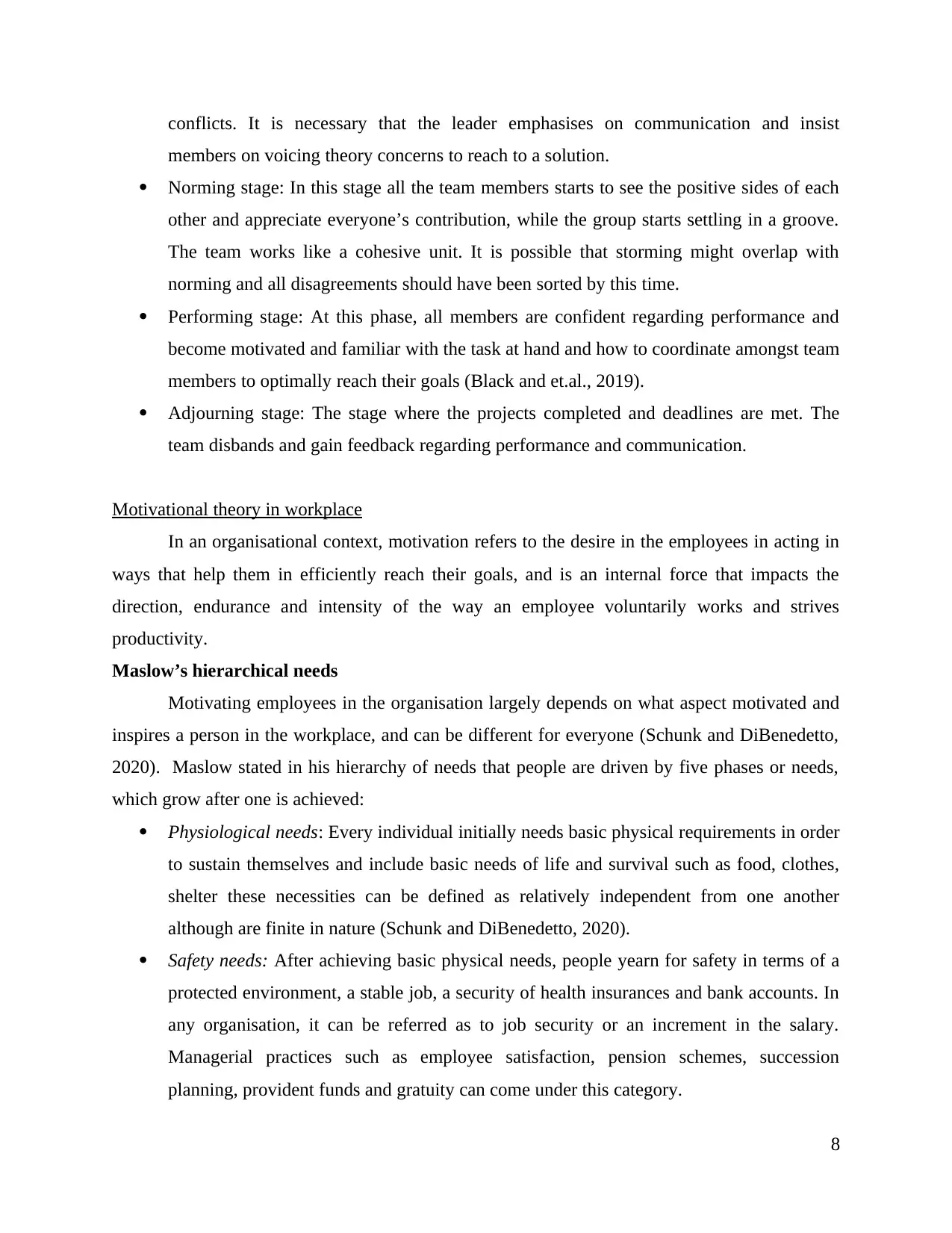
conflicts. It is necessary that the leader emphasises on communication and insist
members on voicing theory concerns to reach to a solution.
Norming stage: In this stage all the team members starts to see the positive sides of each
other and appreciate everyone’s contribution, while the group starts settling in a groove.
The team works like a cohesive unit. It is possible that storming might overlap with
norming and all disagreements should have been sorted by this time.
Performing stage: At this phase, all members are confident regarding performance and
become motivated and familiar with the task at hand and how to coordinate amongst team
members to optimally reach their goals (Black and et.al., 2019).
Adjourning stage: The stage where the projects completed and deadlines are met. The
team disbands and gain feedback regarding performance and communication.
Motivational theory in workplace
In an organisational context, motivation refers to the desire in the employees in acting in
ways that help them in efficiently reach their goals, and is an internal force that impacts the
direction, endurance and intensity of the way an employee voluntarily works and strives
productivity.
Maslow’s hierarchical needs
Motivating employees in the organisation largely depends on what aspect motivated and
inspires a person in the workplace, and can be different for everyone (Schunk and DiBenedetto,
2020). Maslow stated in his hierarchy of needs that people are driven by five phases or needs,
which grow after one is achieved:
Physiological needs: Every individual initially needs basic physical requirements in order
to sustain themselves and include basic needs of life and survival such as food, clothes,
shelter these necessities can be defined as relatively independent from one another
although are finite in nature (Schunk and DiBenedetto, 2020).
Safety needs: After achieving basic physical needs, people yearn for safety in terms of a
protected environment, a stable job, a security of health insurances and bank accounts. In
any organisation, it can be referred as to job security or an increment in the salary.
Managerial practices such as employee satisfaction, pension schemes, succession
planning, provident funds and gratuity can come under this category.
8
members on voicing theory concerns to reach to a solution.
Norming stage: In this stage all the team members starts to see the positive sides of each
other and appreciate everyone’s contribution, while the group starts settling in a groove.
The team works like a cohesive unit. It is possible that storming might overlap with
norming and all disagreements should have been sorted by this time.
Performing stage: At this phase, all members are confident regarding performance and
become motivated and familiar with the task at hand and how to coordinate amongst team
members to optimally reach their goals (Black and et.al., 2019).
Adjourning stage: The stage where the projects completed and deadlines are met. The
team disbands and gain feedback regarding performance and communication.
Motivational theory in workplace
In an organisational context, motivation refers to the desire in the employees in acting in
ways that help them in efficiently reach their goals, and is an internal force that impacts the
direction, endurance and intensity of the way an employee voluntarily works and strives
productivity.
Maslow’s hierarchical needs
Motivating employees in the organisation largely depends on what aspect motivated and
inspires a person in the workplace, and can be different for everyone (Schunk and DiBenedetto,
2020). Maslow stated in his hierarchy of needs that people are driven by five phases or needs,
which grow after one is achieved:
Physiological needs: Every individual initially needs basic physical requirements in order
to sustain themselves and include basic needs of life and survival such as food, clothes,
shelter these necessities can be defined as relatively independent from one another
although are finite in nature (Schunk and DiBenedetto, 2020).
Safety needs: After achieving basic physical needs, people yearn for safety in terms of a
protected environment, a stable job, a security of health insurances and bank accounts. In
any organisation, it can be referred as to job security or an increment in the salary.
Managerial practices such as employee satisfaction, pension schemes, succession
planning, provident funds and gratuity can come under this category.
8
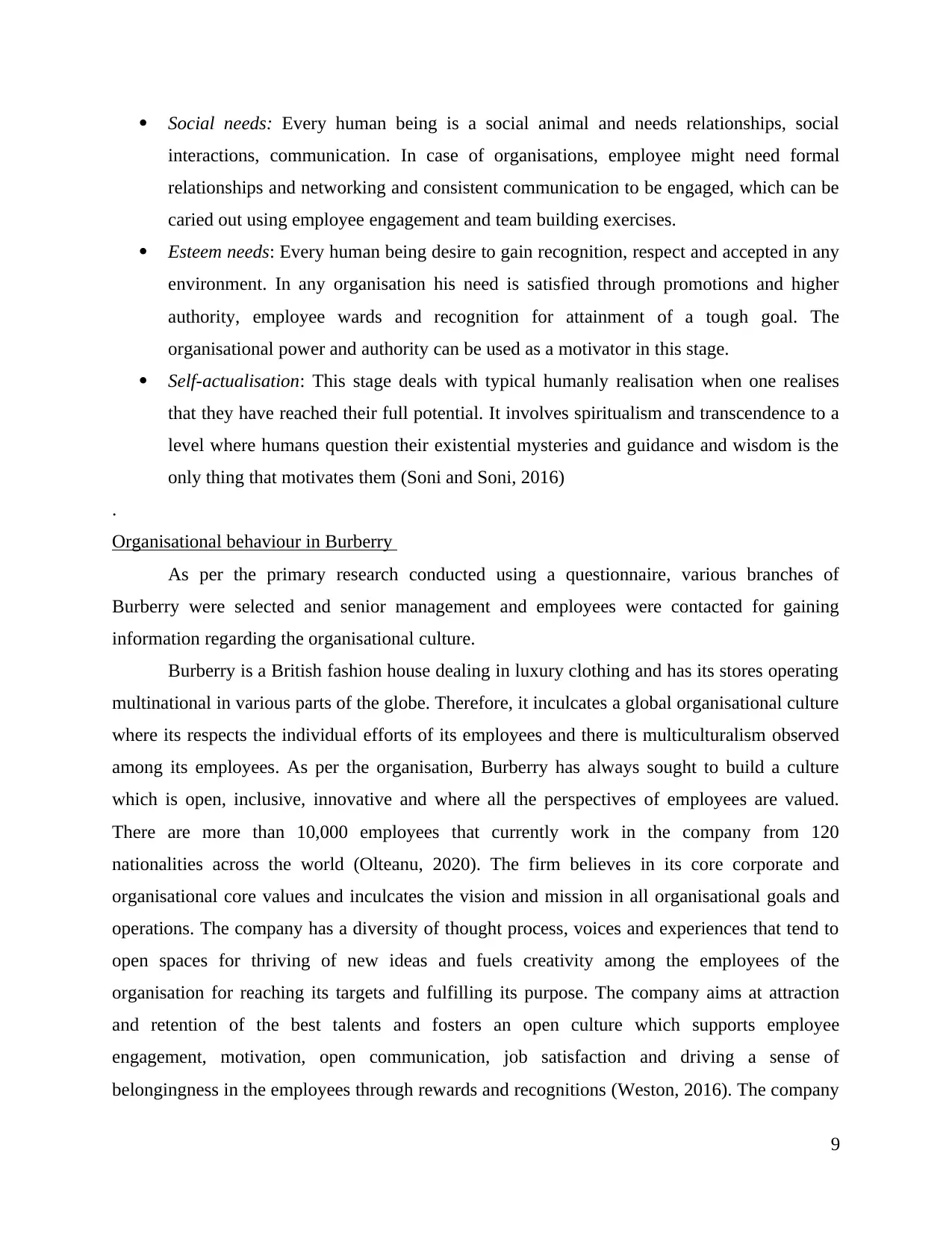
Social needs: Every human being is a social animal and needs relationships, social
interactions, communication. In case of organisations, employee might need formal
relationships and networking and consistent communication to be engaged, which can be
caried out using employee engagement and team building exercises.
Esteem needs: Every human being desire to gain recognition, respect and accepted in any
environment. In any organisation his need is satisfied through promotions and higher
authority, employee wards and recognition for attainment of a tough goal. The
organisational power and authority can be used as a motivator in this stage.
Self-actualisation: This stage deals with typical humanly realisation when one realises
that they have reached their full potential. It involves spiritualism and transcendence to a
level where humans question their existential mysteries and guidance and wisdom is the
only thing that motivates them (Soni and Soni, 2016)
.
Organisational behaviour in Burberry
As per the primary research conducted using a questionnaire, various branches of
Burberry were selected and senior management and employees were contacted for gaining
information regarding the organisational culture.
Burberry is a British fashion house dealing in luxury clothing and has its stores operating
multinational in various parts of the globe. Therefore, it inculcates a global organisational culture
where its respects the individual efforts of its employees and there is multiculturalism observed
among its employees. As per the organisation, Burberry has always sought to build a culture
which is open, inclusive, innovative and where all the perspectives of employees are valued.
There are more than 10,000 employees that currently work in the company from 120
nationalities across the world (Olteanu, 2020). The firm believes in its core corporate and
organisational core values and inculcates the vision and mission in all organisational goals and
operations. The company has a diversity of thought process, voices and experiences that tend to
open spaces for thriving of new ideas and fuels creativity among the employees of the
organisation for reaching its targets and fulfilling its purpose. The company aims at attraction
and retention of the best talents and fosters an open culture which supports employee
engagement, motivation, open communication, job satisfaction and driving a sense of
belongingness in the employees through rewards and recognitions (Weston, 2016). The company
9
interactions, communication. In case of organisations, employee might need formal
relationships and networking and consistent communication to be engaged, which can be
caried out using employee engagement and team building exercises.
Esteem needs: Every human being desire to gain recognition, respect and accepted in any
environment. In any organisation his need is satisfied through promotions and higher
authority, employee wards and recognition for attainment of a tough goal. The
organisational power and authority can be used as a motivator in this stage.
Self-actualisation: This stage deals with typical humanly realisation when one realises
that they have reached their full potential. It involves spiritualism and transcendence to a
level where humans question their existential mysteries and guidance and wisdom is the
only thing that motivates them (Soni and Soni, 2016)
.
Organisational behaviour in Burberry
As per the primary research conducted using a questionnaire, various branches of
Burberry were selected and senior management and employees were contacted for gaining
information regarding the organisational culture.
Burberry is a British fashion house dealing in luxury clothing and has its stores operating
multinational in various parts of the globe. Therefore, it inculcates a global organisational culture
where its respects the individual efforts of its employees and there is multiculturalism observed
among its employees. As per the organisation, Burberry has always sought to build a culture
which is open, inclusive, innovative and where all the perspectives of employees are valued.
There are more than 10,000 employees that currently work in the company from 120
nationalities across the world (Olteanu, 2020). The firm believes in its core corporate and
organisational core values and inculcates the vision and mission in all organisational goals and
operations. The company has a diversity of thought process, voices and experiences that tend to
open spaces for thriving of new ideas and fuels creativity among the employees of the
organisation for reaching its targets and fulfilling its purpose. The company aims at attraction
and retention of the best talents and fosters an open culture which supports employee
engagement, motivation, open communication, job satisfaction and driving a sense of
belongingness in the employees through rewards and recognitions (Weston, 2016). The company
9
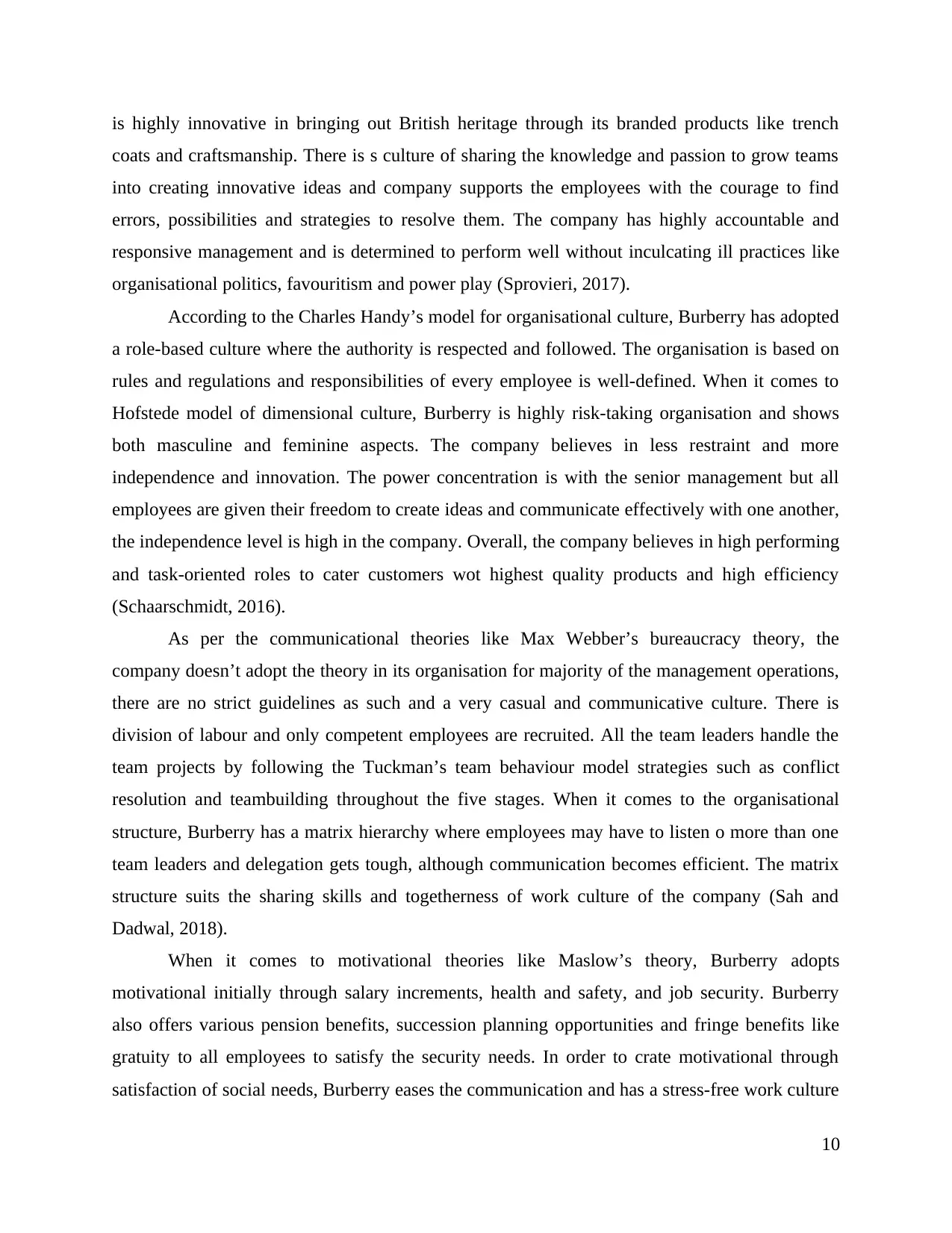
is highly innovative in bringing out British heritage through its branded products like trench
coats and craftsmanship. There is s culture of sharing the knowledge and passion to grow teams
into creating innovative ideas and company supports the employees with the courage to find
errors, possibilities and strategies to resolve them. The company has highly accountable and
responsive management and is determined to perform well without inculcating ill practices like
organisational politics, favouritism and power play (Sprovieri, 2017).
According to the Charles Handy’s model for organisational culture, Burberry has adopted
a role-based culture where the authority is respected and followed. The organisation is based on
rules and regulations and responsibilities of every employee is well-defined. When it comes to
Hofstede model of dimensional culture, Burberry is highly risk-taking organisation and shows
both masculine and feminine aspects. The company believes in less restraint and more
independence and innovation. The power concentration is with the senior management but all
employees are given their freedom to create ideas and communicate effectively with one another,
the independence level is high in the company. Overall, the company believes in high performing
and task-oriented roles to cater customers wot highest quality products and high efficiency
(Schaarschmidt, 2016).
As per the communicational theories like Max Webber’s bureaucracy theory, the
company doesn’t adopt the theory in its organisation for majority of the management operations,
there are no strict guidelines as such and a very casual and communicative culture. There is
division of labour and only competent employees are recruited. All the team leaders handle the
team projects by following the Tuckman’s team behaviour model strategies such as conflict
resolution and teambuilding throughout the five stages. When it comes to the organisational
structure, Burberry has a matrix hierarchy where employees may have to listen o more than one
team leaders and delegation gets tough, although communication becomes efficient. The matrix
structure suits the sharing skills and togetherness of work culture of the company (Sah and
Dadwal, 2018).
When it comes to motivational theories like Maslow’s theory, Burberry adopts
motivational initially through salary increments, health and safety, and job security. Burberry
also offers various pension benefits, succession planning opportunities and fringe benefits like
gratuity to all employees to satisfy the security needs. In order to crate motivational through
satisfaction of social needs, Burberry eases the communication and has a stress-free work culture
10
coats and craftsmanship. There is s culture of sharing the knowledge and passion to grow teams
into creating innovative ideas and company supports the employees with the courage to find
errors, possibilities and strategies to resolve them. The company has highly accountable and
responsive management and is determined to perform well without inculcating ill practices like
organisational politics, favouritism and power play (Sprovieri, 2017).
According to the Charles Handy’s model for organisational culture, Burberry has adopted
a role-based culture where the authority is respected and followed. The organisation is based on
rules and regulations and responsibilities of every employee is well-defined. When it comes to
Hofstede model of dimensional culture, Burberry is highly risk-taking organisation and shows
both masculine and feminine aspects. The company believes in less restraint and more
independence and innovation. The power concentration is with the senior management but all
employees are given their freedom to create ideas and communicate effectively with one another,
the independence level is high in the company. Overall, the company believes in high performing
and task-oriented roles to cater customers wot highest quality products and high efficiency
(Schaarschmidt, 2016).
As per the communicational theories like Max Webber’s bureaucracy theory, the
company doesn’t adopt the theory in its organisation for majority of the management operations,
there are no strict guidelines as such and a very casual and communicative culture. There is
division of labour and only competent employees are recruited. All the team leaders handle the
team projects by following the Tuckman’s team behaviour model strategies such as conflict
resolution and teambuilding throughout the five stages. When it comes to the organisational
structure, Burberry has a matrix hierarchy where employees may have to listen o more than one
team leaders and delegation gets tough, although communication becomes efficient. The matrix
structure suits the sharing skills and togetherness of work culture of the company (Sah and
Dadwal, 2018).
When it comes to motivational theories like Maslow’s theory, Burberry adopts
motivational initially through salary increments, health and safety, and job security. Burberry
also offers various pension benefits, succession planning opportunities and fringe benefits like
gratuity to all employees to satisfy the security needs. In order to crate motivational through
satisfaction of social needs, Burberry eases the communication and has a stress-free work culture
10
Secure Best Marks with AI Grader
Need help grading? Try our AI Grader for instant feedback on your assignments.
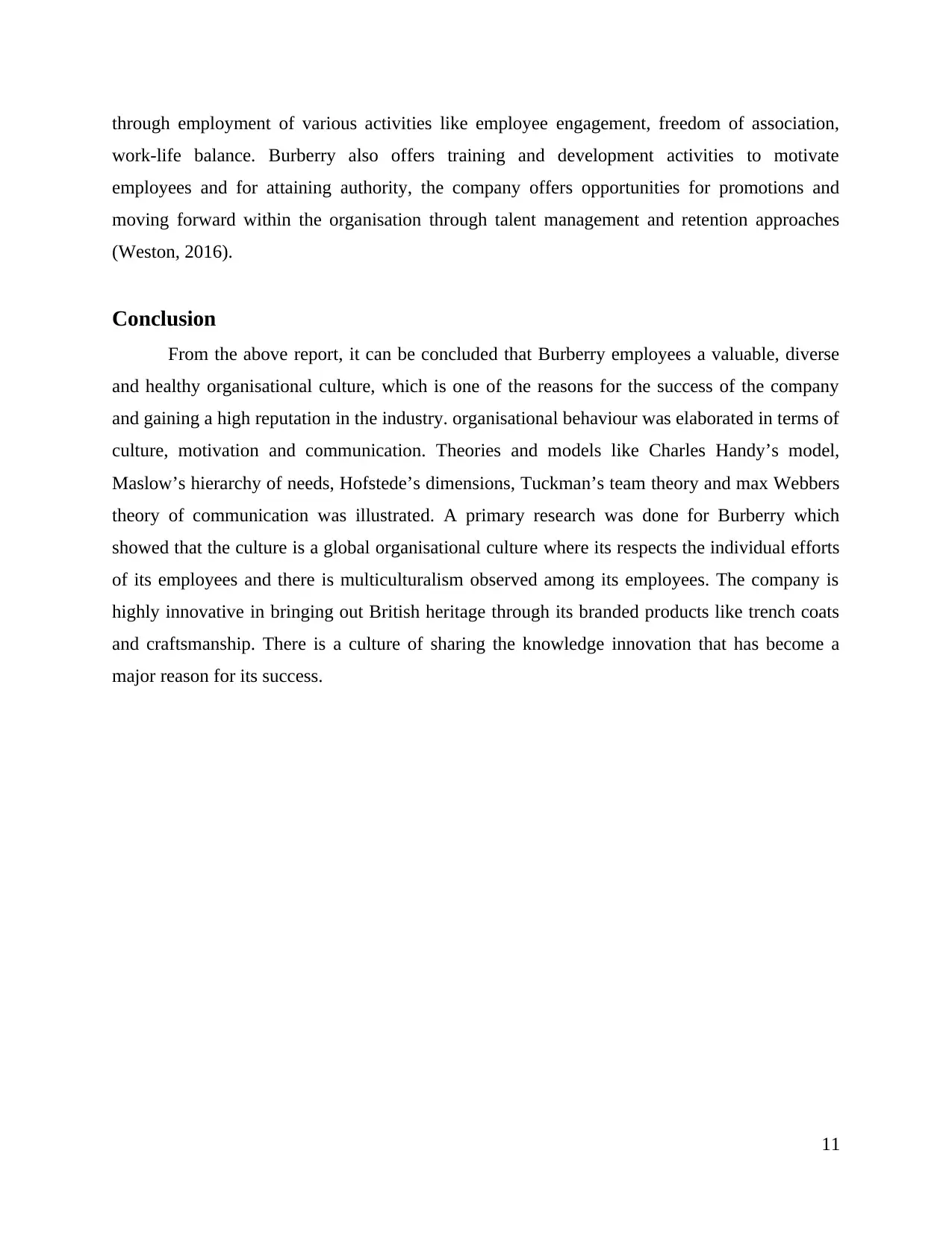
through employment of various activities like employee engagement, freedom of association,
work-life balance. Burberry also offers training and development activities to motivate
employees and for attaining authority, the company offers opportunities for promotions and
moving forward within the organisation through talent management and retention approaches
(Weston, 2016).
Conclusion
From the above report, it can be concluded that Burberry employees a valuable, diverse
and healthy organisational culture, which is one of the reasons for the success of the company
and gaining a high reputation in the industry. organisational behaviour was elaborated in terms of
culture, motivation and communication. Theories and models like Charles Handy’s model,
Maslow’s hierarchy of needs, Hofstede’s dimensions, Tuckman’s team theory and max Webbers
theory of communication was illustrated. A primary research was done for Burberry which
showed that the culture is a global organisational culture where its respects the individual efforts
of its employees and there is multiculturalism observed among its employees. The company is
highly innovative in bringing out British heritage through its branded products like trench coats
and craftsmanship. There is a culture of sharing the knowledge innovation that has become a
major reason for its success.
11
work-life balance. Burberry also offers training and development activities to motivate
employees and for attaining authority, the company offers opportunities for promotions and
moving forward within the organisation through talent management and retention approaches
(Weston, 2016).
Conclusion
From the above report, it can be concluded that Burberry employees a valuable, diverse
and healthy organisational culture, which is one of the reasons for the success of the company
and gaining a high reputation in the industry. organisational behaviour was elaborated in terms of
culture, motivation and communication. Theories and models like Charles Handy’s model,
Maslow’s hierarchy of needs, Hofstede’s dimensions, Tuckman’s team theory and max Webbers
theory of communication was illustrated. A primary research was done for Burberry which
showed that the culture is a global organisational culture where its respects the individual efforts
of its employees and there is multiculturalism observed among its employees. The company is
highly innovative in bringing out British heritage through its branded products like trench coats
and craftsmanship. There is a culture of sharing the knowledge innovation that has become a
major reason for its success.
11
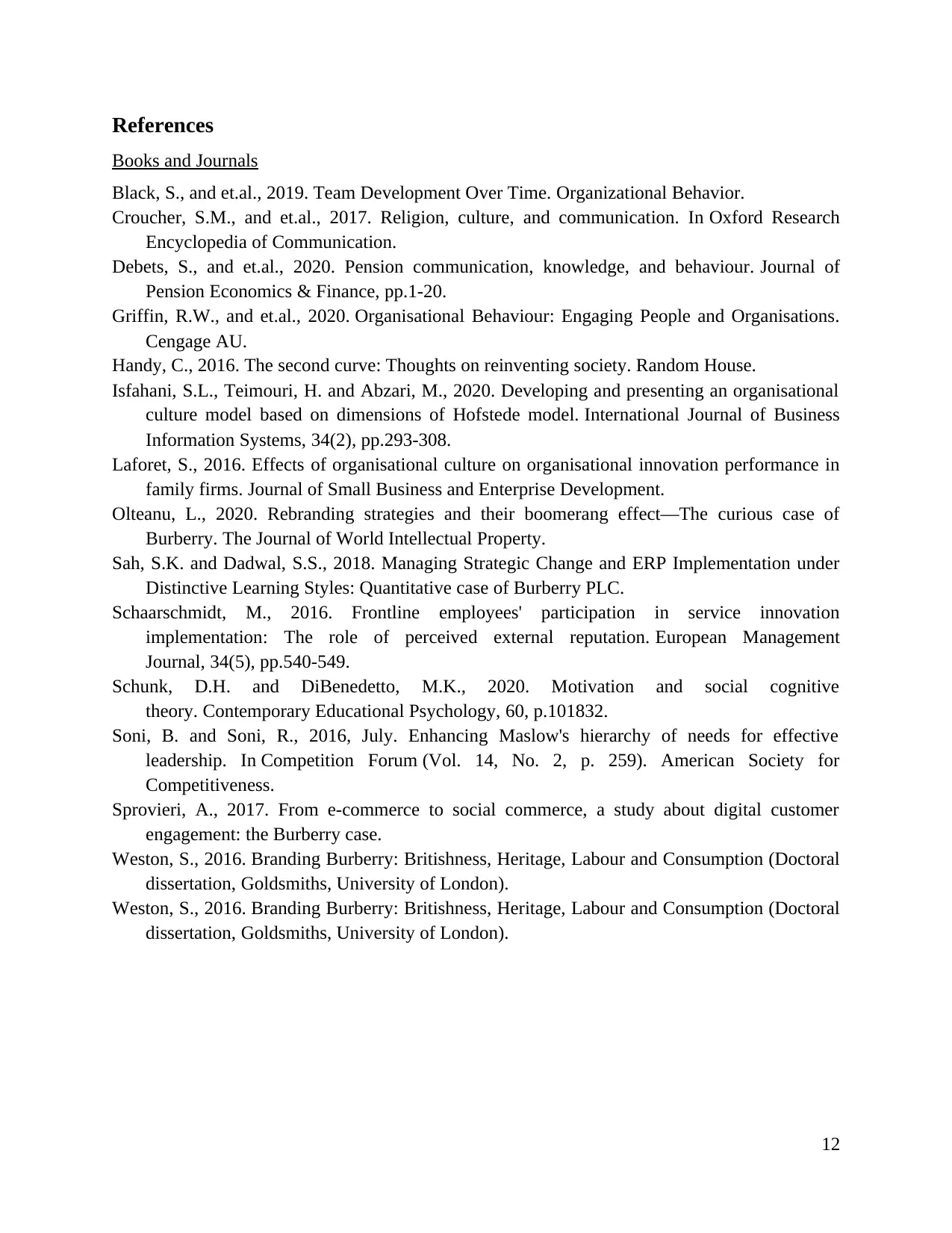
References
Books and Journals
Black, S., and et.al., 2019. Team Development Over Time. Organizational Behavior.
Croucher, S.M., and et.al., 2017. Religion, culture, and communication. In Oxford Research
Encyclopedia of Communication.
Debets, S., and et.al., 2020. Pension communication, knowledge, and behaviour. Journal of
Pension Economics & Finance, pp.1-20.
Griffin, R.W., and et.al., 2020. Organisational Behaviour: Engaging People and Organisations.
Cengage AU.
Handy, C., 2016. The second curve: Thoughts on reinventing society. Random House.
Isfahani, S.L., Teimouri, H. and Abzari, M., 2020. Developing and presenting an organisational
culture model based on dimensions of Hofstede model. International Journal of Business
Information Systems, 34(2), pp.293-308.
Laforet, S., 2016. Effects of organisational culture on organisational innovation performance in
family firms. Journal of Small Business and Enterprise Development.
Olteanu, L., 2020. Rebranding strategies and their boomerang effect—The curious case of
Burberry. The Journal of World Intellectual Property.
Sah, S.K. and Dadwal, S.S., 2018. Managing Strategic Change and ERP Implementation under
Distinctive Learning Styles: Quantitative case of Burberry PLC.
Schaarschmidt, M., 2016. Frontline employees' participation in service innovation
implementation: The role of perceived external reputation. European Management
Journal, 34(5), pp.540-549.
Schunk, D.H. and DiBenedetto, M.K., 2020. Motivation and social cognitive
theory. Contemporary Educational Psychology, 60, p.101832.
Soni, B. and Soni, R., 2016, July. Enhancing Maslow's hierarchy of needs for effective
leadership. In Competition Forum (Vol. 14, No. 2, p. 259). American Society for
Competitiveness.
Sprovieri, A., 2017. From e-commerce to social commerce, a study about digital customer
engagement: the Burberry case.
Weston, S., 2016. Branding Burberry: Britishness, Heritage, Labour and Consumption (Doctoral
dissertation, Goldsmiths, University of London).
Weston, S., 2016. Branding Burberry: Britishness, Heritage, Labour and Consumption (Doctoral
dissertation, Goldsmiths, University of London).
12
Books and Journals
Black, S., and et.al., 2019. Team Development Over Time. Organizational Behavior.
Croucher, S.M., and et.al., 2017. Religion, culture, and communication. In Oxford Research
Encyclopedia of Communication.
Debets, S., and et.al., 2020. Pension communication, knowledge, and behaviour. Journal of
Pension Economics & Finance, pp.1-20.
Griffin, R.W., and et.al., 2020. Organisational Behaviour: Engaging People and Organisations.
Cengage AU.
Handy, C., 2016. The second curve: Thoughts on reinventing society. Random House.
Isfahani, S.L., Teimouri, H. and Abzari, M., 2020. Developing and presenting an organisational
culture model based on dimensions of Hofstede model. International Journal of Business
Information Systems, 34(2), pp.293-308.
Laforet, S., 2016. Effects of organisational culture on organisational innovation performance in
family firms. Journal of Small Business and Enterprise Development.
Olteanu, L., 2020. Rebranding strategies and their boomerang effect—The curious case of
Burberry. The Journal of World Intellectual Property.
Sah, S.K. and Dadwal, S.S., 2018. Managing Strategic Change and ERP Implementation under
Distinctive Learning Styles: Quantitative case of Burberry PLC.
Schaarschmidt, M., 2016. Frontline employees' participation in service innovation
implementation: The role of perceived external reputation. European Management
Journal, 34(5), pp.540-549.
Schunk, D.H. and DiBenedetto, M.K., 2020. Motivation and social cognitive
theory. Contemporary Educational Psychology, 60, p.101832.
Soni, B. and Soni, R., 2016, July. Enhancing Maslow's hierarchy of needs for effective
leadership. In Competition Forum (Vol. 14, No. 2, p. 259). American Society for
Competitiveness.
Sprovieri, A., 2017. From e-commerce to social commerce, a study about digital customer
engagement: the Burberry case.
Weston, S., 2016. Branding Burberry: Britishness, Heritage, Labour and Consumption (Doctoral
dissertation, Goldsmiths, University of London).
Weston, S., 2016. Branding Burberry: Britishness, Heritage, Labour and Consumption (Doctoral
dissertation, Goldsmiths, University of London).
12
1 out of 12
Related Documents
Your All-in-One AI-Powered Toolkit for Academic Success.
+13062052269
info@desklib.com
Available 24*7 on WhatsApp / Email
![[object Object]](/_next/static/media/star-bottom.7253800d.svg)
Unlock your academic potential
© 2024 | Zucol Services PVT LTD | All rights reserved.




